The voice of passion is better than the voice of reason. The passionless cannot change history. |
|
TOMORROW: My Book World | Lynne Olson's Last Hope Island: Britain, Occupied Europe, and the Brotherhood That Helped Turn the Tide of War
0 Comments
FRIDAY: My Book World | Lynne Olson's Last Hope Island: Britain, Occupied Europe, and the Brotherhood That Helped Turn the Tide of War
The Stonewall riots were a key moment for gay people. Throughout modern history, gays had thought of themselves as something like a mental illness or maybe a sin or a crime. Gay liberation allowed us to make the leap to being a “minority group,” which made life much easier. --Edmund White, speaking of Stonewall Riots 1969 FRIDAY: My Book World | Lynne Olson's Last Hope Island: Britain, Occupied Europe, and the Brotherhood That Helped Turn the Tide of War
The following post may be a bit self-indulgent—much longer than normal—but I simply must get what's bothering me off my chest. Trigger warning: if confessions or whining in any way get you going, then stop reading now. You are forgiven. It irritates my partner Ken, when I’m sometimes told I look good (or young) for my age. I make this statement not as a matter of ego or vanity (well, not entirely) but as a point of departure for a vapid little tale of humor, irony, and maybe stupidity. It’s one that began long ago.  Dick and Vic c1971 Dick and Vic c1971 When I was twenty-five, I worked at the Texas Tech University library in cataloging and often was mistaken for an undergraduate. When I introduced my twenty-year-old brother visiting from CU in Boulder, one librarian thought we were twins! Brother Vic was not amused. I shrugged but glowed inside with giddiness. It happened again in my thirties, but by then I was rather cultivating the notion that had been planted in my head at twenty-five. I worked out at a gym, remained slim. I was young. I located a book (BOMC) that explained in a very hippy dippy manner, how to care for your skin naturally (with plasters of oatmeal paste, toner squeezed from a lemon). Someone said I looked happy. Sitting in a doctor’s office, I also ran across an article, in a ratty old magazine that I stole, about facial isometric exercises that strengthen the muscles beneath the face and chin. There are five exercises, and I’ve done them several times weekly since 1978, in large part, if I’m not in a hospital or on vacation. 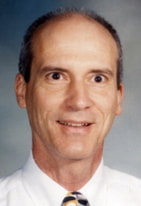 Dick, LHS Faculty Pic Dick, LHS Faculty Pic As I reached my forties and fifties and worked sixty-hour weeks, I didn’t hear much of that you-look-so-young kind of talk anymore. I became bald and gray. My job as a teacher of AP English stressed my face beyond belief (faculty yearbook pictures remain as proof). And if you have kids yourself, you just might not find it beyond belief that caring for young people can indeed age you. It was only at age fifty-four, when I retired, that I was able to relax and get a good night’s sleep, eat and exercise properly—regaining a certain vigor, vitality, and youth. I also learned to meditate, quieting the mind each morning that provided yet another layer of peace to my existence. When I obtained a new doctor in the next decade, he did a doubletake when I announced that I was sixty-nine. I thought you were more like forty-seven. Ken, attending the appointment as my advocate, snorted and rolled his eyes yet again, and I didn’t blame him. It was fatuous of me to sit there and grin. A year later, as I went under sedation for a heart ablation, a bevy of nurses gushed, You are not seventy! What is your secret? As a joke, and as my last cogent words before succumbing to the general anesthetic, I murmured, “Good clean living.” The woman’s fading voice answered: “I’m a little late for thaaaat . . . .” I’ve neglected to mention regular movement as a major contributor to my vigor and good health. Since I’ve acquired a Fitbit watch, I try to walk between 6,000 and 8,000 (3.5 miles) steps per day. I’ve logged as many as 12,000 or 17,000 (8.8 miles) in one day while sightseeing in Barcelona, Spain. I’ve also done Pilates workouts since 2002, whose exercises have strengthened and challenged my core, toned up all my muscles. Reduced back pain because fit muscles help keep your skeletal remains aligned properly. Mostly, but you have to keep after it.  A Segment of Our Backyard Walking Trail A Segment of Our Backyard Walking Trail During Covid, Ken and I had a walking trail of crushed granite installed in the backyard, combined with a narrow sidewalk and the patio, to meander from one end of the yard to the other. We do own a treadmill, but it is pleasurable to get outside and stride naturally on the ground. The trail provides a “track” whose lap is equal to one minute’s time. On June 18, I was about to finish my walk—ten more minutes—when I tripped on a protruding drain spout. I had grazed it before and was aware of its presence, but that time I nailed it (or it nailed me), and the next thing I knew . . . I found myself face down on the sidewalk . . . the victim of gravity’s dark pull against the earth, that feeling of How’d I get here? My glasses and airpods were scattered like items at the scene of an accident—which, of course, it was. I’d been listening to The Plot Thickens, a fascinating Turner Classic Movies podcast production about the life of actor-comedian, Lucille Ball. Her whisky tenor (bass!) is still bellowing in my ear. But all I can think of is the old saw from the Bible, Proverbs 16:18. To paraphrase, “Pride Goeth before a Fall.” 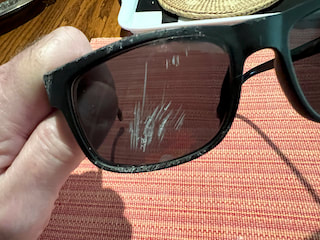 Yes, upon my word, I crash to earth with the full weight of gravity against my back, smashing my youthful face—more precisely against my thick black sunglasses, which gouge a gash in my forehead but which most probably save me from breaking my nose or cheekbone. My first thought is, This isn’t good. Already a small pool of blood has gathered on the pavement, and it continues to drip from my head. I quickly remove the shirt I am wearing and it becomes a rag, a way to stanch the bleeding (I later tell Ken to toss it in the trash, I never wish to see it again). I somehow have the wherewithal (and balance) to rise from all fours, abandon my fallen belongings and find my way inside to view myself in the bathroom mirror. This is not good, indeed. My right eyebrow is sporting a large gash in the way that a peach’s skin can sustain a gash upon falling from the tree, demonstrating really, how delicate human skin is. I inform Ken that I’ve got to get to an urgent care center ASAP (eschewing the three-hour wait at any hospital ER in town). 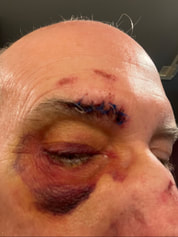 We arrive at Star ER on the South Loop at about four p.m., and the waiting room is empty. In attempting to fill out the remarkably simple paperwork, my head drips blood onto the floor. The receptionist says not to worry; they’ll clean it up. I’m holding back the blood with a single folded tissue brought from home; it is full, a plump crimson rose. Soon I’m called back to an examining room. The man waiting on me is a middle-aged, jocular doctor with multi-striped frames and tinted lenses. He injects Lidocaine (a cousin to Novocain) into a wide swath of my forehead, some of its coolness dribbling down my face. He now cleans the wound with a stinging antiseptic that would otherwise be making me scream and proceeds to make nine surgical stitches to mend that laceration along my right eyebrow (a friend jokes that I should take a Sharpie and do my left brow so that they match, ha ha). When the doctor is done, a woman disinfects the remaining abrasions on my hands, arms, knees, and legs. The place runs a CT scan on my head, and we wait. The doctor returns and informs me there is a small bleed in my brain, and he orders an ambulance to fetch me and rush me across town to University Medical Center. But not serious enough to elicit sirens. The driver takes the Loop to Marsha Sharp Freeway, shortening the drive to seven minutes or less. When I arrive at UMC, it is six p.m., and I’m rolled on a gurney into Trauma Unit #1. It seems as if twenty people leap upon my body at once (and in other circumstances such a situation might be rather tantalizing), but more probably the best-looking group of men and women I’ve ever seen, some medical students, some young doctors, begin to work away at me in a joint but chaotic effort. Some hands untie my shoes and remove my polka dot socks (I’m not picky about what I wear during my backyard strolls). Other hands in this kind of assault pull off my running shorts and athletic supporter (oh, really, doctor), my shirt. Next, a handsome man (even masked) in blue scrubs, a Doctor Vincent, badgers me with questions: First, my family history of diseases, and I tell him. Do I drink? Yes, socially. Socially like every day or just Saturdays? None of your business. And then he asks me how my accident happened. Some chatty youngsters stab holes in my left arm for IV’s (at least one of them a mistake because she happens to confess), and one hole in my right arm, I suppose for a different drip yet to come. I’m turned on my left side (“One, two, three, turn), and another set of hands pounds each vertebrae, and I am to yell (to be heard above the cacophony) “No” if it doesn’t hurt with each attack. None does. I’m asked to squeeze my butt cheeks (incidentally, one of my Pilates exercises—20 squeezes per set—designed to help keep my buttocks high and perky, meh). Good job, a male voice says not entirely with sincerity. All of these things are done to me as if I'm a plastic dummy, a doll on which to practice their pin-pricking and other medical stuff—as if I am not real. I’m turned on my right side (“One, two, three, turn) for yet another purpose. Then I’m laid flat (without getting laid) on my back again. All of these actions take place on a thin, flat board slipped between my back and the gurney. Asked if I hurt, I must amaze all concerned, instead of complaining about the mess on my head, by informing them I have four titanium screws in my spine from a previous surgery—and that that board is fucking killing me. They plaster a pain-relieving pad across my lower back, which will remain there during my entire stay, thus relieving some of the pain caused by lying in hospital beds. Because I may be cognitively challenged after the fall, I’m bombarded with even more questions that I must answer satisfactorily, because suddenly the room empties as if my ass just isn’t up to snuff for this crowd (recall, if you will, my veiled rape metaphor). I am now moved to an Intensive Care Unit room with only a curtain to separate me from the tumult, and an Asian woman with an ESL accent takes a long history and types it into the computer. Several times she, also a student, is helped by the youngish man who heads the main desk—his being the only bitchy personality I encounter during the weekend. Until midnight, when I am moved to a regular room, I languish on this uncomfortable bed with nothing but my thoughts. Ever since I was at Star ER I’ve run through my meditation mantras, attempting to take my mind off the obvious: injury and trauma. The mantras help a little, but they are shouted down by competing thoughts of pain, thoughts about my ruined looks, thoughts of how long I’ll be spending in this life-saving but God awful place. Finally, at midnight, after several false starts (I easily eavesdrop on the main desk phone calls), I’m moved to a regular single room, GT-392. I ask the orderly rolling me along the hallways what GT stands for because my inquiring mind (as dinged-up as it is) wants to know. He mumbles something about it just being named that way. Yet he forgets that I can read the overhead signs as we travel through this labyrinthine building, and I note “Gerontology and Trauma” printed in large letters as we near my room. Ah haaa. Yet my placement is a blessing. Gone is the puerile chatter of ICU workers. Gone is the bustle of gurneys in and out of slamming doors. Agonizing moans and screams not my own. My GT room is quiet, and for the next thirty-six hours, I am allowed to sleep except for short interruptions to take my vitals, draw yet more blood, and whatever else the staff wish to do to me or for me (I'm served several good meals). Except for a couple of plump, gray-haired female nurses, everyone else, male or female, who enters the room, seems young. But even they are plump, out of breath if they exert themselves in any way. Serving twelve-hour shifts, it seems, these faithful servants obviously have no time to work out, to keep fit. The only rather thin, short man in blue scrubs happens to be a physician from the neurology department, who deems that I shall be released later Monday morning. Everyone who has entered my room—from orderlies, to aides, to nurses and doctors—seems to take seriously the hospital motto, “Service Is Our Passion.” So unlike the private hospital a mile and a half from here, or like hospitals from my past, in which I felt lucky to get the time of day or a response to my request radioed to the nurse’s station by that walkie talkie lying next to my head. Late Monday morning, a cute young blonde nurse named Kristina rushes around to help me prepare to check out. I ask if I can shower my smelly body, and she accommodates me by getting the trickle of warm water started in the walk-in shower (no scalding allowed here). She leaves to get my paperwork in order. It’s faster and cheaper to buy my new RXs from the UMC pharmacy, so Kristina also dispatches an aide downstairs to secure them for me: I happen to have cash to facilitate matters. After my shower, Kristina and I get my belongings together. I sign a bunch of paperwork, copies of it go in an already existing folder, and I am wheeled downstairs by the same aide to the front entrance, where Ken is waiting to pick me up. Ah, after the fall. Since I’m stubbornly not on social media any longer (except for LinkedIn, which may not count), I send an email or texts with photos to friends and loved ones. I get the responses of sympathy I was probably hoping to elicit: Wishes for a quick recovery, Things could have been worse, You still look handsome. Oh, yeah, that’s the one I was waiting to read. I’m gonna be all right. Yes, nine days later, many of the scabs have already fallen away, leaving a pink layer of new skin. I exude a little pride here, but mostly gratitude. Yes, I'm very grateful.
TOMORROW: A Writer's Wit | The 1969 Stonewall Riots
My Book World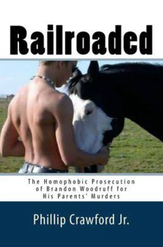 Woodruff with His Horse Woodruff with His Horse Crawford, Phillip, Jr. Railroaded: The Homophobic Prosecution of Brandon Woodruff for His Parents’ Murders. Kindle: CreateSpace, 2018. Full disclosure: I won this Kindle version of Crawford’s book by way of a goodreads.com giveaway. I am providing this review because I do believe it is a narrative worth reading. This brief book is reminiscent of absorbing feature articles I’ve read in Texas Monthly—stories of true crime set in the Lone Star State. As a gay man who has lived in Texas for over fifty years, I felt drawn to this case I’d never heard of before. Woodruff is a nineteen-year-old boy charged with murdering his parents in their home. Crawford displays a fine grasp of the tenuous legal situation for gays in Texas, and he sets up the facts of the case for readers to see that Brandon Woodruff is wrongly prosecuted and convicted. At the very least the teen should be given a fair trial. Throughout the book Crawford makes clear, among others, certain facts. A Texas Ranger from Austin is assigned the case, rather than a local or regional official. This Ranger conducts a smear campaign against Brandon because of his participation in a gay social life and for appearing in legitimate pornographic movies, “evidence” that has nothing to do with the case but which prejudices the jury. The Ranger also fails to take advantage of information that does exist, for one, cell phone records that would indicate Brandon is not anywhere near the location at the time of the murders. By such evidence alone, he could not possibly have committed the murders. While some guilty parties never show any emotion when hearing the news of loved one’s murders, reliable witnesses testify that Brandon loves his parents, particularly his father, who has a sympathetic view of his son’s homosexuality—and he is beset with grief from the beginning. Brandon’s sister, who is more temperamentally bent toward anger and violence against their parents than Brandon, is never fully investigated. What about her whereabouts on the night of the murder? Her phone records? A party or parties who might have committed the murders on her behalf? One suspect, an ex-friend of Brandon’s who is vehemently homophobic, lies to Ranger Collins, and Collins conveniently never puts the ex-buddy on the stand at the trial. The Texas Ranger takes the easy way out all around, and Brandon Woodruff, now nearing age thirty-six, still remains in prison, a long life-term ahead of him. If readers want to help Brandon Woodruff’s cause, they can go to the website freebrandon.org to donate and/or sign a petition to be sent to the Texas Court of Criminal Appeals. This is a wrong that must be righted and soon. Thanks to Phillip Crawford, Jr. for documenting this case in such a decisive manner. NEXT FRIDAY: My Book World | Lynne Olson's Last Hope Island: Britain, Occupied Europe, and the Brotherhood That Helped Turn the Tide of War
TOMORROW: My Book World | Phillip Crawford, Junior's Railroaded: The Homophobic Prosecution of Brandon Woodruff for His Parents' Murders
FRIDAY: My Book World | Phillip Crawford, Junior's Railroaded: The Homophobic Prosecution of Brandon Woodruff for His Parents' Murders
FRIDAY: My Book World | Phillip Crawford, Junior's Railroaded: The Homophobic Prosecution of Brandon Woodruff for His Parents' Murders
My Book World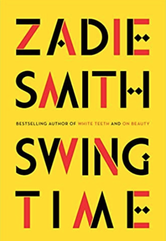 Smith, Zadie. Swing Time. New York: Penguin, 2016. I often make marginal notes throughout a novel I read, but I allowed this one to wash over me instead, primarily because I couldn’t put it down. Swing Time is, in part, a showbiz novel because the narrator, following college, gains employment as a personal assistant for an American pop star ten years her senior, the single-named Aimee. But first readers must learn of this nameless narrator’s early life in London in which her best friend (at the time) is also biracial (her mother black, her father white, whereas the situation is reversed for her friend, Tracey). She and Tracey meet in dance class, and Tracey’s “pig nose” is highlighted numerous times in the beginning so that one never forgets what Tracey is like, both her looks and her demeanor. She is a slovenly, take-no-prisoners, strong-willed female whom the narrator admires, at least to a point. Though Tracey winds up with the “real” career in show business as a dancer, it is the narrator who, for a decade, at least, derives some status by way of a well-paid and exciting career. The novel makes a big leap when the setting moves from the UK to Africa, where pop star Aimee decides to build a school for children. The narrator is then dragged into a milieu for which she is unprepared. I admire the way in which Smith seamlessly advances the novel with a back-and-forth movement from era to era, from location to location, chapter by chapter, until readers arrive once again at the present day (2018) of cell phones and social media, phenomena lacking during the girls’ childhoods of the early 1980s. The narrator commits one great sin involving her boss, Aimee, and loses her job. She then returns to London to catch up with her mother, a feminist, who has never been the nurturer her father was. A great read that explores contemporary treatment of race, fame, family, and friendship. NEXT FRIDAY: My Book World | Phillip Crawford, Junior's Railroaded: The Homophobic Prosecution of Brandon Woodruff for His Parents' Murders
TOMORROW: My Book World | Zadie Smith's Swing Time
FRIDAY: My Book World | Zadie Smith's Novel Swing Time
FRIDAY: My Book World | Zadie Smith's Novel Swing Time
My Book World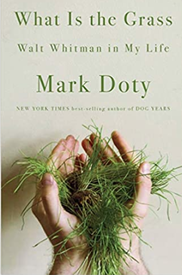 Doty, Mark. What Is the Grass: Walt Whitman in My Life. New York: Norton, 2020. This alternately erudite and yet expressive book is enjoyable on a number of levels. If readers are acquainted with both Doty’s prose and poetry, they know that not a word is out of place or mischosen in any way. Doty’s book is divided into five parts each exploring a facet by which readers might find a way into Walt Whitman’s era, his life, and his poetry. It might be used as a textbook for teaching Whitman, at least as an ancillary source. I am now inspired to go to my shelves and reach for that volume of Whitman, whose work I have only touched the surface of. Intertwined with Doty’s exegeses of Whitman’s work are bits and pieces of Doty’s own life and how, as his title suggests, Whitman’s life and work have influenced him. I have only one complaint, and that is with W. W. Norton. I’m not a copyeditor, and I don’t look for typographical errors when I read, but at least ten jumped out at me, from subject-verb agreement to putting a space between text and an em dash to repeating two words in a row that should not be repeated. One sentence had the verb agreeing with the object of the preposition instead of the actual subject. Pages 45, 106, 115, 134, 150, 154, 174, 231, 254, 269—in case others should like to find them for themselves. These errors are not the responsibility of the author. Shame on Norton—the last independent press in America. To say the least, the company has done better. NEXT FRIDAY: My Book World | Zadie Smith's Swing Time
TOMORROW: My Book World | Mark Doty's What Is the Grass: Walt Whitman in My Life
FRIDAY: My Book World | Mark Doty's What Is the Grass: Walt Whitman in My Life
FRIDAY: My Book World | Mark Doty's What Is the Grass: Walt Whitman in My Life
My Book World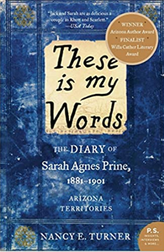 Turner, Nancy E. These Is My Words: The Diary of Sarah Agnes Prine, 1881-1901. A Novel. New York: Harper, 1998. This book has remained unread on my shelf a long time, I think, in part, because I would always be put off by the apparent poverty of the title. It belies the intelligence of the narrator and story she has to tell. Set in mostly late 1880s of the Arizona Territories, the novel relates itself in the form a diary, a twenty-year period in the life of a young woman, the man she marries, their children, and almost all related family members. While the frontier adventures are exciting (some unique and some exactly like those found in earlier books), the novel may be limited by two factors. One is the author’s use of first person. Readers mostly receive Sarah Prine’s take on things, a bright but uneducated (for a while) youth. The other may be the form of using a diary. Both features seem to limit the amount or kind of information a novel can tell. On the other hand, the author makes good use of both methods to tell this tale of a young woman faced with many pioneer-like challenges: extremes in weather, battles with natives, sexism, childbirth, premature deaths in the family, and more. It offers a personal touch the third person might not. The diary format strengthens the female point of view which may be lost or obscured by male writers of similar historical fiction or literature. I still believe shelf appeal might have been increased by at least straightening out the grammar of the title. How about These Are My Words? NEXT FRIDAY: My Book World | Mark Doty's What Is the Grass: Walt Whitman in My Life.
TOMORROW: My Book World | Nancy Turner's These Is My Words
FRIDAY: My Book World | Nancy Turner's These Is My Words
|
AUTHOR
Richard Jespers is a writer living in Lubbock, Texas, USA. See my profile at Author Central:
http://amazon.com/author/rjespers Archives
June 2024
Categories
All
Blogroll
Websites
|
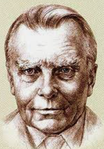
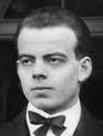
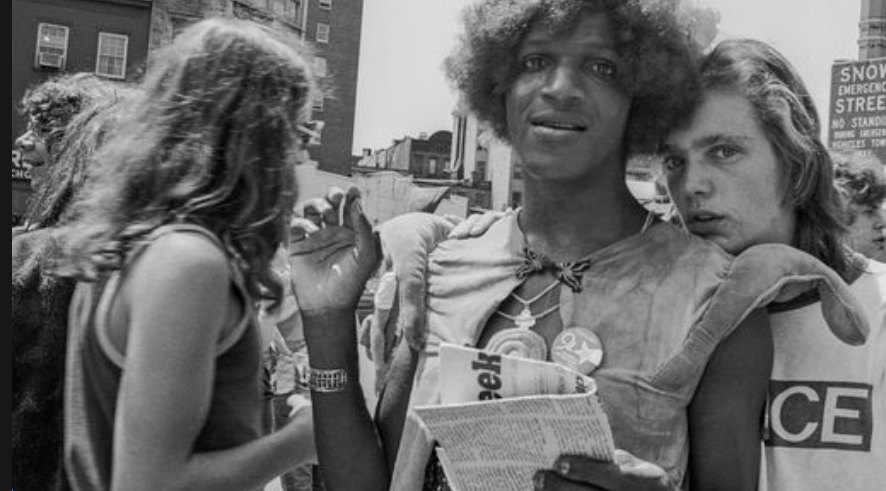




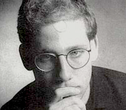
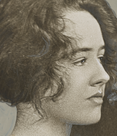
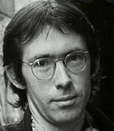



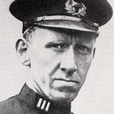











 RSS Feed
RSS Feed